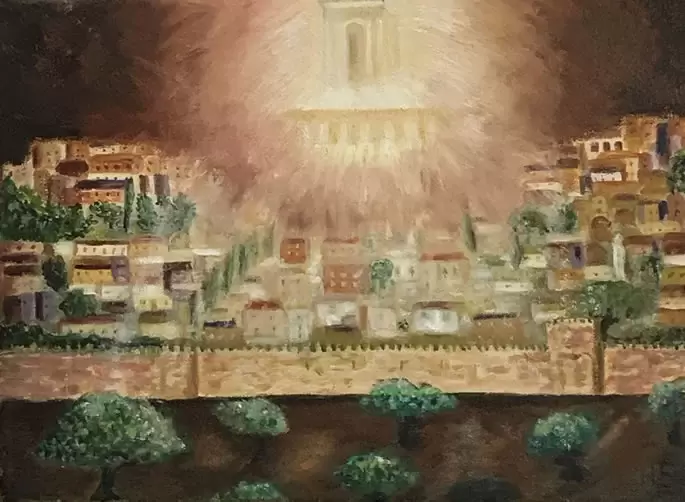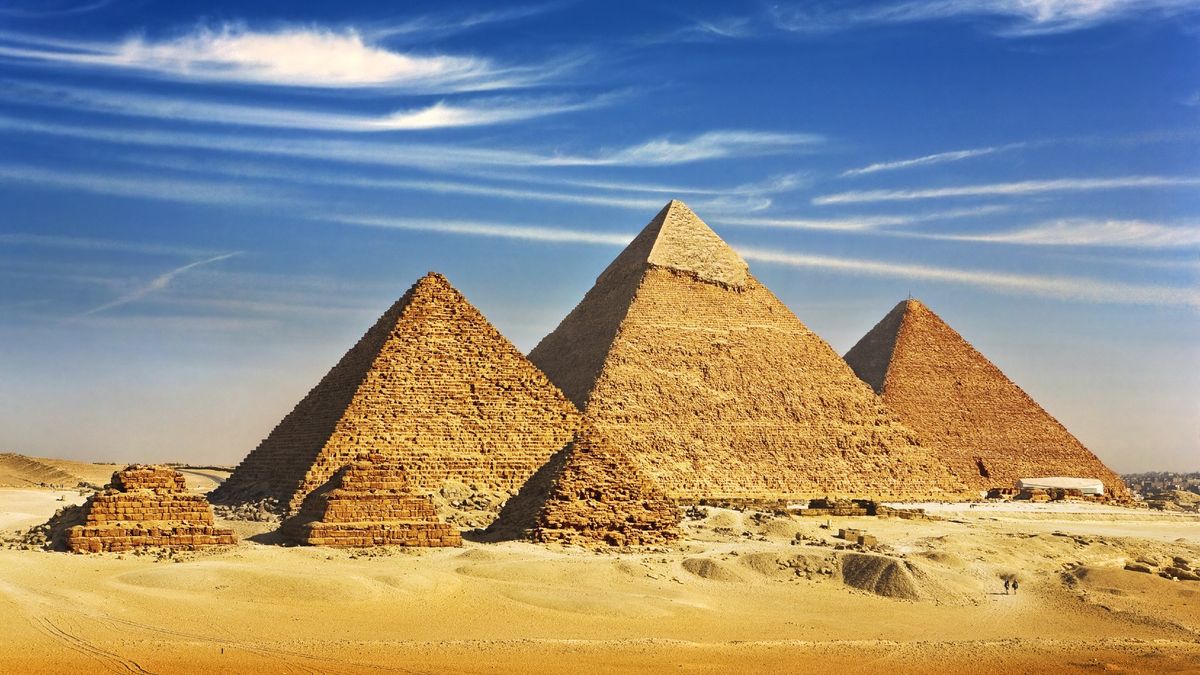 Rabbi David Etengoff ה' יעזור וירחם על אחינו כל בני ישראל, בארץ ישראל ובכל חלקי הארץ Yimot hamashiach (Days of the Mashiach), like many popular terms, is frequently used and just as often little understood. Yeshayahu describes it in this manner in the haftorah for the last day of Pesach: And a wolf shall live with a lamb, and a leopard shall lie with a kid; and a calf and a lion cub and a fatling [shall lie] together, and a small child shall lead them. And a cow and a bear shall graze together, their children shall lie; and a lion, like cattle, shall eat straw. And an infant shall play over the hole of an old snake and over the eyeball of an adder, a weaned child shall stretch forth his hand. (11:6-8, translation, The Judaica Press Complete Tanach) Shmuel (165-257 C.E.), known as one of the greatest Talmudic Sages, understands these pasukim in a metaphoric sense. As such, instead of a world wherein the instinctual behaviors of the animal kingdom will be radically altered, we will be blessed to live in a time when our people will be free from the yoke of our oppressors: “There will be no difference between our world and the days of the Messiah except for the cessation of the domination of the kingdoms of the world [over the Jewish people].” (Talmud Bavli, Sanhedrin 99a, translation and brackets my own) Thus, for Shmuel, yimot hamashiach will be a time of complete socio-political freedom for the Jewish people. In his halachic magnum opus, Mishneh Torah, Hilchot Melachim 11:1 and 12:1 and 2, the Rambam (1135-1204) elucidates Shmuel’s position in this fashion: King Messiah will arise in the future and return the kingship of David to its former greatness and glory. He will rebuild the Holy Temple and gather all of the exiles to the Land of Israel. All of the laws will be in effect during his days just as they were in earlier times. We will [once again] offer korbanot (animal offerings) and keep the laws of the Sabbatical and Jubilee years just like all of the other laws stated in the Torah. One ought not to think that in the days of the Messiah anything will change in the nature of the world (m’minhago shel haolam), or that there will be some new creation within nature (b’ma’aseh Bereishit). Rather, the world will continue in its normal fashion. The passage in Yeshayahu that states “And a wolf shall live with a lamb, and a leopard shall lie with a kid…” is merely a metaphor. Rather, it really means that the Jewish people will live in comfort and without fear of the evil non-Jewish nations who are symbolically represented by the terms “wolf” and “leopard.” Our Sages stated: “There will be no difference between our world and the days of the Messiah except for the cessation of the domination of the kingdoms of the world [over the Jewish people].” (Translation, underlining, and brackets my own) One is immediately struck by the purely naturalistic position taken by the Rambam. The reinstitution of the Davidic monarchy “to its former greatness and glory” in the person of the true Messiah is the necessary and fundamental criterion for the achievement of all other Jewish eschatological goals. “Former greatness and glory” refers to uncontested Jewish hegemony over our own G-d-promised land. Pragmatically, it means that the unending political pressures faced by the modern State of Israel will cease. Moreover, since all countries will recognize our beloved nation as Hashem’s unique dwelling place among humankind, it will be preeminent in the world. This will be a natural result of the nations of the world “returning to the true faith,” that is, monotheism (12:5). Once we are politically free and no longer beholden to any earthly power, the Melech Hamashiach will “rebuild the Holy Temple and gather all of the exiles to the Land of Israel.” The Anshei Kenesset HaGadolah (Men of the Great Assembly) gave powerful voice to these aspirations in two brachot of the Shemoneh Esrei: And may You return to Your holy city in mercy, and dwell therein as You have spoken. And may You build it soon and in our days as a permanent construction. And may the throne of King David rapidly be re-established therein. Blessed are You Hashem, He who builds Jerusalem. Sound the great shofar [whose clarion call] declares our freedom. And raise up our standard to gather around all of our exiles and gather us all together from the four corners of the earth. Blessed are You Hashem, He who gathers the exiles of His people Israel. (Translation and brackets my own) May this Pesach be the time wherein these tefilot will be answered. V’chane yihi ratzon. Shabbat Shalom and Chag Kasher v’Sameach Past drashot may be found at my blog-website: http://reparashathashavuah.org Please contact me at [email protected] to be added to my weekly email list. *** My audio shiurim on the topics of Tefilah and Tanach may be found at: http://tinyurl.com/8hsdpyd *** I have posted 164 of Rabbi Soloveitchik’s English language audio shiurim (MP3 format) spanning the years 1958-1984. Please click on the highlighted link: The Rav
0 Comments
 Rabbi David Etengoff ה' יעזור וירחם על אחינו כל בני ישראל, בארץ ישראל ובכל חלקי הארץ Our natural inclination at this time of the year is to focus upon the phrase, zacher l’yetziat mitzraim —a remembrance of the Exodus from Egypt. This is the case, since one of the major mitzvot of Pesach evening is none other than l’saper b’yetziat mitzraim—to tell the story of the departure from Egypt. While this is a key element of our thoughts during the course of the Seder, the Torah also reminds us, no less than five times, “And you shall remember that you were a slave in the land of Egypt...” (Sefer Devarim 5:15, 15:15, 16:12, 24:18 and 24:22, this and all Tanach translations, The Judaica Press Complete Tanach with my emendations) As such, while we are obligated to focus upon our joyous march to freedom on the night of Pesach, we are equally mandated to remember our 210-year ordeal of backbreaking servitude and abject misery at the hands of our heartless Egyptian taskmasters. Two of the five instances wherein the Torah enjoins us to “remember that you were a slave in the land of Egypt...” explicitly discuss our responsibility to treat the stranger, orphan, and widow in an equitable and righteous manner: You shall not pervert the judgment of a stranger or an orphan, and you shall not take a widow's garment as security [for a loan]. You shall remember that you were a slave in Egypt, and Hashem, your G-d, redeemed you from there; therefore, I command you to do this thing. (Sefer Devarim 24:17-18) When you beat your olive tree, you shall not pick all its fruit after you; it shall be [left] for the stranger, the orphan, and the widow. When you pick the grapes of your vineyard, you shall not glean after you: it shall be [left] for the stranger, the orphan, and the widow. You shall remember that you were a slave in the land of Egypt: therefore, I command you to do this thing. (24:20-22) These verses urge us to guard the rights and privileges of the most powerless members of Jewish society by reminding us that our entire nation was once completely vulnerable and subject to the diabolical control of Pharaoh and his henchmen. Therefore, as a people and as individuals, we should ever remember our Egyptian servitude and become acutely sensitive to the needs of those who need our help to live dignified and meaningful lives. In other words, the Torah is commanding us to practice the highest standards of social justice. The Rambam (Maimonides, 1135-1204) codifies our moral and halachic imperative to actively provide for the needs of those most at risk in a well-known halacha regarding the mitzvah of simchat Yom Tov (rejoicing during the Yom Tov meal): When a person eats and drinks [in celebration of a holiday], he is obligated to feed converts, orphans, widows, and others who are destitute and poor. In contrast, a person who locks the gates of his courtyard and eats and drinks with his children and his wife, without feeding the poor and the embittered, is [not indulging in] rejoicing associated with a mitzvah, but rather the rejoicing of his belly. (Mishneh Torah, Hilchot Yom Tov 6:18, translation, Rabbi Eliyahu Touger with my emendations) The Rambam is teaching us a profound life lesson that goes far beyond a specific Yom Tov-based halacha, namely, kol Yisrael arevim zeh bazeh—every Jew is personally responsible for the welfare of every other Jew, and no one should be left behind. Little wonder, then, that in the opening words of the Haggadah we declare as one: This is the bread of affliction that our ancestors ate in the land of Egypt. All those who are hungry, let them enter and eat. All who are in need, let them come celebrate the Passover. Now we are here. Next year in the land of Israel. This year we are enslaved. Next year may we be free. (http://www.mazoncanada.ca/wp-content/uploads/2015/03/2015-Passover-Resource.pdf) B’shanah haba b’yerushalayim habanuyah!—may we join as one united people in the rebuilt Beit HaMikdash soon, and in our days. V’chane yihi ratzon. Shabbat Shalom and Chag Kasher v’Sameach Past drashot may be found at my blog-website: http://reparashathashavuah.org Please contact me at [email protected] to be added to my weekly email list. *** My audio shiurim on the topics of Tefilah and Tanach may be found at: http://tinyurl.com/8hsdpyd *** I have posted 164 of Rabbi Soloveitchik’s English language audio shiurim (MP3 format) spanning the years 1958-1984. Please click on the highlighted link: The Rav  Rabbi David Etengoff ה' יעזור וירחם על אחינו כל בני ישראל, בארץ ישראל ובכל חלקי הארץ The primary focus of our parasha is the illness known as tzaraat. In his Commentary on the Torah, the Rashbam (1080-1158) presents the unique nature of this disease: All of the sections dealing with the negayim (afflictions) affecting people, garments, houses, and the manner in which they appear as well as the number of days requiring sequestering, the white, black, and golden identifying hairs—cannot be understood by following the simple and direct meaning of the text. Neither may we rely upon standard human knowledge and expertise [that is, current medical information]. Instead, we must follow the analysis of the Sages, their decrees, and the inherited body of knowledge that they received from the earliest Sages. This is the essence [of this matter]. (Introduction to Parashat Tazria, translation and brackets my own) In the Rashbam’s view, tzaraat can be understood solely from the Torah’s standpoint, rather than from a physiological or medical perspective. This is because its etiology does not follow the normative laws of biology. Instead, it is a spiritually-based ailment that manifests in a physical fashion. The Torah presents us with three types of tzaraat: “If a man has a se’et, a sapahat, or a baheret on the skin of his flesh, and it forms a lesion of tzaraat on the skin of his flesh, he shall be brought to Aharon the Kohen, or to one of his sons, the Kohanim.” (Sefer Vayikra 13:1, this and all Tanach translations, The Judaica Press Complete Tanach, with my emendations) Midrash Vayikra Rabbah, Tazria 15:9, identifies each of these categories as metaphorically representing one of the ancient nations who either violently injured or sought to harm our people. Thus, “se’et [a rising] is Babylonia... sapahat [a scab] is [the kingdom of the] Medes... and baharet [a bright spot] is Greece.” (This and the following translation, Darosh Darash Yosef: Discourses of Rav Yosef Dov Halevi Soloveitchik on the Weekly Parashah, Rabbi Avishai C. David editor, pages 227-228) Our midrash notes that Haman, who attempted to eradicate our people, was the most infamous member of the ancient Medes: “[The kingdom of the] Medes raised Haman the wicked, who crawled like a snake, as it is written, ‘On your belly you shall go.’” (Sefer Bereishit 3:4) My rebbe and mentor, Rabbi Joseph B. Soloveitchik zatzal (1903-1993), known as “the Rav” by his students and followers, builds upon our midrash and describes Haman in the following fashion: ...[he] slithered like a snake but was puffed up with arrogance. A fawning personality, he lacked dignity. His sycophantic behavior resulted in his becoming prime minister to King Ahashverosh. Yet, Haman was no leader. A weak and spineless man, he used flattery to get ahead. Thinking that it would save his life, he behaved in a servile manner toward Esther even after she exposed him. Like other haughty people, he did not realize how base he was, that he was actually a form of sapahat. (Darosh Darash Yosef, page 231, underlining and italics my own) In the Rav’s view, the haughty and arrogant Haman emerges as a base and slithering being who lacked all manner of dignity to the extent that “he was actually a form of sapahat.” What does it mean for a person to be “a form of sapahat,” to be a scab on the body of humanity in general, and an enemy of the Jewish people in particular? The Rav indirectly addresses this question in his analysis of those who demonstrate ga’avah (arrogant pretentiousness) and pursue kavode (false honor): If, however, one pursues these qualities, then they are false and reprehensible. This is particularly the case if one actively deceives himself and pretends to be someone other than who he really is...The greatest falsehood takes place when a person lies to himself. (Rabbi Yosef Dov Halevi Soloveitchik, Yimei HaZikaron, page 208, Sifiriyat Elinor, editor, translation and brackets my own) Haman is the ultimate example of an individual who “actively deceives himself and pretends to be someone other than who he really is.” He convinced himself that he had geut--grandeur, when in fact, he was merely “puffed up with arrogance” born of self-delusion and grandiose visions. Moreover, the Rav asserts, Haman’s ga’avah was nothing other than “a negative character trait, a form of spiritual tzaraat...Therefore, we must avoid ga’avah and be careful not to behave like Haman, who thought that only he was worthy of honor.” (Darosh Darash Yosef, page 231) As such, according to the Rav, Haman epitomized the notion that “the greatest falsehood takes place when a person lies to himself.” The Rav continues his presentation and emphasizes that, in stark contrast to the spiritual tzaraat of ga’avah demonstrated by Haman and others of his ilk, Hashem has true geut and must therefore be recognized as He Who acts with grandeur. As King David and Yeshayahu the prophet taught us so long ago: Hashem has reigned; He has attired Himself with majesty (geut)... (Sefer Tehillim 93:1) In the land of uprightness, he [the evil one] deals unjustly, and he does not see the majesty (geut) of Hashem. (Sefer Yeshayahu 26:10) Sing to Hashem for He has performed majestic deeds (geut); this is known throughout the land. (Sefer Yeshayahu, 12:5) As the Rav underscores many times, “The principle of imitatio dei [imitating Hashem’s behaviors] demands that we emulate G-d’s attributes.” (Darosh Darash Yosef, page 231) Therefore, may we always reject ga’avah and the spiritual tzaraat it represents, and embrace the authentic majesty of geut Hashem V’chane yihi ratzon. Shabbat Shalom Past drashot may be found at my blog-website: http://reparashathashavuah.org Please contact me at [email protected] to be added to my weekly email list. *** My audio shiurim on the topics of Tefilah and Tanach may be found at: http://tinyurl.com/8hsdpyd *** I have posted 164 of Rabbi Soloveitchik’s English language audio shiurim (MP3 format) spanning the years 1958-1984. Please click on the highlighted link: The Rav |
Details
Archives
July 2024
AuthorTalmid of Rabbi Soloveitchik zatzal Categories |
- Blog: Rabbi David Etengoff: Parashat HaShavuah
- Sefer Bereishit 5784&5785
- Sefer Shemot 5784&5785
- Sefer Vayikra 5784&5785
- Sefer Bamidbar 5784 &5785
- Sefer Bereishit 5782&5783
- Sefer Shemot 5782&5783
- Sefer Vayikra 5782&5783
- Sefer Bamidbar 5782&5783
- Sefer Devarim 5782&5783
- Sefer Bereishit 5780& 5781
- Sefer Shemot 5780&5781
- Sefer Vayikra 5780&5781
- Sefer Bamidbar 578&5781
- Sefer Devarim 578&5781
- Sefer Bereishit 5778&5779
- Sefer Shemot 5778&5779
- Sefer Vayikra 5778&5779
- Sefer Bamidbar 5778&5779
- Sefer Devarim 5778&5779
- Sefer Bereishit 5776&5777
- Sefer Bereishit 5774&5775
- Sefer Bereishit 5772&5773
- Sefer Bereishit 5771&5770
- Sefer Shemot 5776&5777
- Sefer Shemot 5774&5775
- Sefer Shemot 5772&5773
- Sefer Shemot 5771&5770
- Sefer Vayikra 5776&5777
- Sefer Vayikra 5774&5775
- Sefer Vayikra 5772&5773
- Sefer Vayikra 5771&5770
- Sefer Bamidbar 5776&5777
- Sefer Bamidbar 5774&5775
- Sefer Bamidbar 5772&5773
- Sefer Bamidbar 5771&5770
- Sefer Devarim 5776&5777
- Sefer Devarim 5774&5775
- Sefer Devarim 5772&5773
- Sefer Devarim 5771&5770
 RSS Feed
RSS Feed
